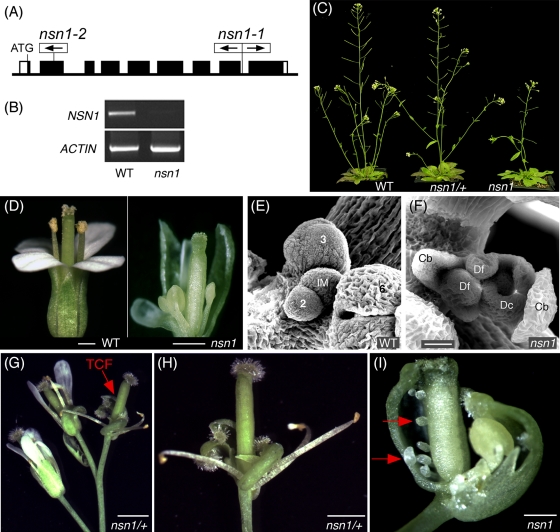FIGURE 2:
Termination of inflorescence meristem and homeotic transformation of floral organs in nsn1. (A) nsn1-1 (SALK_029201) contained two T-DNA inserts in the eighth intron of the NSN1 gene, and nsn1-2 (RAFL11-2045-1) had one transposon in the second exon. Framed arrows indicate the direction of T-DNA or transposon. (B) RT-PCR showing the lack of detectable NSN1 mRNA in homozygous nsn1-1 plants. ACTIN mRNA served as a control. Nsn1-LP and Nsn1-RP were used as primers (for their positions see Supplemental Figure S3A) for RT-PCR, which generated a cDNA fragment of 1050 base pairs. (C) Phenotypes of 30-d-old WT, nsn1-1/+, and nsn1 plants. Heterozygous nsn1/+ plants showed no obvious growth phenotype but had significant defects in reproduction. Homozygous nsn1 plants were very small and yielded only a few seeds per plant. (D) A flower at position 25 from the lower part of inflorescence of a 40-d-old nsn1-1 plant had a reduced number of petals and shortened stamen filaments as compared with a WT flower at the same position of inflorescence. (E, F) Scanning electronic images of the inflorescence meristem (IM) of 40-d-old WT (E) and nsn1 (F) plants. Note that the inflorescence meristem (F) was terminated by the formation of a terminal carpelloid flower (TCF). Cb, carpelloid bract; Dc, defective carpel; Df, defective floral meristem developed inside a TCF. Stages of the WT floral primordia (E) are indicated. (G–I) Inflorescences of nsn1/+ and nsn1 were terminated by the formation of a TCF (red arrow in G), which is shown in a higher magnification (H). A typical TCF of nsn1 would contain homeotically transformed carpelloid bracts, severely defective stamens, and no petals (I). Ectopically developed ovules are indicated by red arrows (I). Shown are the terminal carpelloid flowers at position 35 of nsn1-1/+ (H) and position 36 of nsn1-1 (I). Scale bars, 25 μm (E, F), 2 mm (G), 1 mm (D, H, I).

